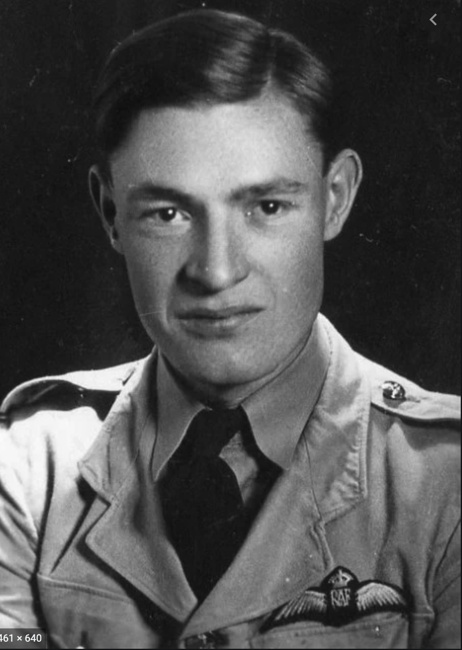A Galaxy of Stars |
 Bill emphatically not when I knew him. When we met he was a sprightly eighty-year old with a winning smile and a shock of white hair. Bill Not all stars are stars of the silver screen. Bill was someone I bumped into around 1996, when I had a share in a Tiger Moth aircraft at Old Sarum airfield near Salisbury. We were in Hangar Three in the covetted corner spot, East end, and opposite was a Jodel (a French all wood monoplane) which had suffered a bird strike at 2,500'. These aren't the deals they are in a large Airbus, and the unfortuanate bird had only broken the thin veneer of ply on the leading edge. I had wandered over to have a look and introduced myself to a very friendly, tall, elderly gentleman of impeccable manners who co-owned the plane, and was in the process of mending it. I was immediately impressed by a level of workmanship that had a curious mix of high precision yet low tech - the replacement piece of wood had been sanded into a scarf joint - simply explained, it's a way of attaching two pieces of wood. A simple butt joint has limited strength due to limited surface area. But if you cut a diagonal in both pieces of wood, you can increase the surface area to take the glue by a factor of ten - and it will be immensely strong. This can be done with plywood, but as you might imagine, the two edges of the scarf joint are sanded to a taper that is paper thin at the end. He had done this with impressive precision, and was now using a dented kettle to steam it into shape. He then glued it on and used a simple stapler to hold it while the adhesive set. It was my introduction to Bill, and he was usually kicking around the hangar when I came down to clean/fly/maintain the moth. He showed me a homebuilt amphibious aircraft that he'd been working on in a corner of the hangar for several years. The layout was similar to a Grumman Duck, with the single sponson protruding forward beyond the prop, and I said so - and we found a shared passion for flying boats. As my sporadic visits to the hangar continued, we shared information and articles about homebuilt flying boats, comparing the Volmer Sportsman with the Kingfisher. I knew he was RAF but little else; he had flown Short Sunderlands (A massive British flying boat) in the war and told me about the time they took 82 people on board whilst evacuating Greece. It would have overladen the aircraft, but he said they had a 'very long runway' meaning the Aegean, so eventually took off. The flight deck of a Sunderland, he said, 'resembled a large greenhouse'. Eagle-eyed readers may recall this was the Flying Boat in which Thursday lives in The Well of Lost plots ; it's a favourite of mine. The homebuilding aircraft movement - yes, that is a thing - is run by the LAA who have been assigned as the regulatory body by the Civil Aviation Authority, and as conversation came round to his homebuilt amphibian, I naturally asked who had drawn up the plans and done the stress calculations. Bill said it was himself, and as it turned out, the aircraft was only vaguely built under the auspices of the LAA - it was being constructed pretty much from Bill's head, using the techniques he thought best, and improvising as he went along. This was kind of impressive and frightening all at the same time, as he was indeed planning to fly it - and my consternation grew as it was revealed that the budget for raw materials was virtually nil: He was building it out of wood he could either liberate from skips or scraps from local manufacturers. In this same way he also sourced an engine, and propellor. That he was the recipient of all this generosity from the aviation community was good, obviously, and at the time I didn't really question it. He was a retired RAF chap, highly amenable and always found time to chat and laugh. In hindsight, of course, I can see exactly why he was given so much assistance. The Tiger Moth moved away from Old Sarum around 2000, and I didn't see Bill again, nor his extraordinary homebuilt amphibian aircraft, a collection of scrap-sourced materials lovingly built with all the diligence of a master craftsmen, using hand tools and his old kettle. It was a few years later that I discovered his full name was Flight Lieutenant James Edward Goldfinch, and he was, along with Jack Best, one of the two people who led the team that designed and built the Colditz Glider while POWs at Oflag IV-C during 1945. I never knew that, and he didn't mention it, and no-one else thought to mention it either - Bill was Bill, respected by all. He didn't talk about his past, and I didn't press him - you don't with ex-forces. He and I just chatted about flying boats and stuff. His homebuilt creation, apparently without strict regulatory approval, had just commenced its first taxiing trial when he passed away in 2007, aged 91. I kind of like to think that everyone who had a peripheral interest in his project - including the CAA - would have turned a blind eye to the eventual proving 'hop'. The thing is, the Colditz Glider never flew after a huge amount of time, effort, danger and sourcing of materials, and I always kind of thought this was Bill settling an old score with history. That ingenuity, time and scrap materials alone could see an aeroplane take flight. |
 Bill's Grumman Duck Amphibian lives on. With wings removed it can be viewed at the Norfolk and Suffolk Aviation Museum near Flixton. Photo: Keith Newsome Recalled 20th April 2020 |